Arctic trophy hunters, tourism and masculinities, 1827-1914
Permanent link
https://hdl.handle.net/10037/10863Date
2016-10-12Type
Journal articleTidsskriftartikkel
Peer reviewed
Author
Aarekol, LenaAbstract
Trophy hunting in the Arctic happened in an intersection between tourism, expeditions and hunting.
This study contributes to a discrete history of masculinity within the context of trophy hunting
organized from North Norway and to a broader understanding of Arctic masculinity in general. As
trophy hunting expeditions are primarily a male, even masculinist, tourist practice, an analysis
from a gender perspective is unavoidable. By taking an empirical approach I investigate different
performances of masculinity in written accounts of Arctic trophy-hunting expeditions from the
period 1827–1914. The use of masculinity as a pivot demonstrates that a modification of the
prevailing perception of Arctic masculinity is necessary. While the general understanding is
dominated by an emphasis on physical strength, roughness, ingenuity, restless energy and strong
will to self-realization, qualities connected to the traditional values and knowledge of trappers,
sailors and explorers, my analysis shows that trophy hunting introduced aristocratic ideals such as
gentlemen’s sport, self- discipline, hunting morals, care for nature and distribution of knowledge
to their home communities. Trophy hunting in the Arctic made possible performances of different
forms of masculinity, not only the conquest and mastery of nature, but also the interest in and
care for nature. Women also accompanied as family members and hunters, and women took part in the
hunt more often than has
been commonly noted.
Description
Manuscript version. Published version available at http://dx.doi.org/10.1080/08003831.2016.1238173


 English
English norsk
norsk